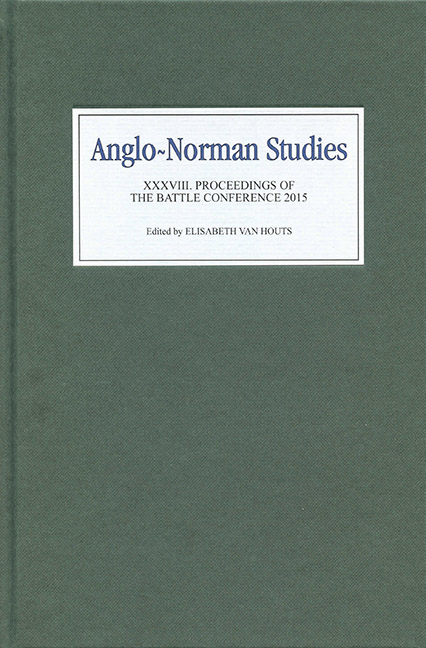Book contents
- Frontmatter
- Contents
- Illustrations and Tables
- Editor's Preface
- Abbreviations
- From the Articles of the Barons to Magna Carta (The R. Allen Brown Memorial Lecture, 2015)
- Jews in the Glosses of a Late Twelfth-Century Anglo-Norman Gratian Manuscript (Cambridge, Gonville and Caius College, MS 283/676)
- Monastic Autonomy, Episcopal Authority and the Norman Conquest: The Records of Barking Abbey (The Marjorie Chibnall Memorial Essay, 2015)
- Economy Distorted, Economy Restored: Order, Economy and Salvation in Anglo-Norman Monastic Writing
- Monastic Patronage and Family Disputes in Eleventh- and Early Twelfth-Century Normandy
- Constance, Princess of Antioch (1130–1164): Ancestry, Marriages and Family
- Early Aristocratic Seals: An Anglo-Norman Success Story
- English Towns and Urban Society after the Norman Conquest
- Wreck of the Sea in Law and Practice in Eleventh- and Twelfth-Century England
- Social Life and Religious Culture in Twelfth-Century Norwich and Norfolk
- Bad Crusaders? The Normans of Southern Italy and the Crusading Movement in the Twelfth Century
- Turold, Wadard and Vitalis: Why Are They on the Bayeux Tapestry?
Turold, Wadard and Vitalis: Why Are They on the Bayeux Tapestry?
Published online by Cambridge University Press: 12 September 2017
- Frontmatter
- Contents
- Illustrations and Tables
- Editor's Preface
- Abbreviations
- From the Articles of the Barons to Magna Carta (The R. Allen Brown Memorial Lecture, 2015)
- Jews in the Glosses of a Late Twelfth-Century Anglo-Norman Gratian Manuscript (Cambridge, Gonville and Caius College, MS 283/676)
- Monastic Autonomy, Episcopal Authority and the Norman Conquest: The Records of Barking Abbey (The Marjorie Chibnall Memorial Essay, 2015)
- Economy Distorted, Economy Restored: Order, Economy and Salvation in Anglo-Norman Monastic Writing
- Monastic Patronage and Family Disputes in Eleventh- and Early Twelfth-Century Normandy
- Constance, Princess of Antioch (1130–1164): Ancestry, Marriages and Family
- Early Aristocratic Seals: An Anglo-Norman Success Story
- English Towns and Urban Society after the Norman Conquest
- Wreck of the Sea in Law and Practice in Eleventh- and Twelfth-Century England
- Social Life and Religious Culture in Twelfth-Century Norwich and Norfolk
- Bad Crusaders? The Normans of Southern Italy and the Crusading Movement in the Twelfth Century
- Turold, Wadard and Vitalis: Why Are They on the Bayeux Tapestry?
Summary
On 1 August 1086, according to the Anglo-Saxon Chronicle, all the important landholders in England, no matter whose men they were, submitted to William the Conqueror at Salisbury, became his men, and swore oaths that they would be loyal to him against all others. We have no record of who did so, but three Domesday Book landholders who had good reason to comply, given that they were tenants of the king's imprisoned half-brother, Bishop Odo of Bayeux, were Ralph son of Turold of Rochester, Wadard, and Vitalis of Canterbury. Wadard and Vitalis are generally considered to be the men of that name who appear in the Bayeux Tapestry and Ralph is likely to have been the son of the tapestry's Turold. All the other named figures in the tapestry, with the possible exception of the mysterious Ælfgyva, were far more prominent persons: kings, a duke, counts, earls, an archbishop, and a bishop. Partly because of their very obscurity, scholars have long sought to uncover who the three men were, the fullest recent effort being by Hirokazu Tsurushima. When it comes to their place in the Bayeux Tapestry, however, most scholars have been interested in what their identities might reveal about its patronage. I am interested instead in why they were included. My approach draws on that of T. A. Heslop, who postulated that the tapestry was designed at least partly for two audiences: Odo of Bayeux's secular followers and his learned clerical colleagues. Heslop was mainly concerned with the latter audience; my focus is on the former. As the Salisbury oath indicates, men like Turold, Wadard and Vitalis mattered under the new Norman regime, and both king and magnates needed their support. I will argue, therefore, that Odo had the tapestry designed partly to celebrate the accomplishments of his followers and thereby show that he was a good lord who valued his military supporters and knights more generally. I will also argue that the tapestry uses the figure of Harold as a foil: a potential hero who could have joined the nexus of loyalties that tied both Odo and his men to William the Conqueror, but instead betrayed William and his followers alike.
- Type
- Chapter
- Information
- Anglo-Norman Studies XXXVIIIProceedings of the Battle Conference 2015, pp. 181 - 197Publisher: Boydell & BrewerPrint publication year: 2016



